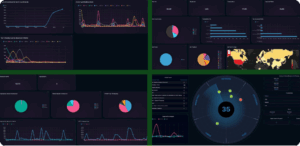
Imagine running a factory full of machines that work 24/7. Or a hospital using smart devices to monitor patients. Someone finds a way to hack those machines or devices. Scary, right?
That’s where Vulnerability Management Service helps. It helps keep your systems protected. Let’s break it down in detail.
What is Vulnerability Management?
Vulnerability management means finding and fixing security weaknesses before hackers can use them. These weaknesses are called “vulnerabilities.” In regular IT systems, like computers or servers, we can scan for these all the time. But for OT (Operational Technology) and IoT (Internet of Things) systems, things get trickier.
- OT includes machines like robots in a factory or control systems in a power plant.
- IoT includes smart devices like security cameras or sensors in a hospital.
These systems are usually always on, hard to update, and often very old. They were never designed with cybersecurity in mind. That makes them vulnerable to cyberattacks.
How GLESEC Does it Differently?
GLESEC’s SKYWATCH platform offers a Vulnerability Management Service designed specifically for OT, IoT, and IT systems.
Instead of active testing (which can disrupt sensitive systems), GLESEC uses a non-intrusive and AI-powered approach. This included advanced vulnerability detection, firmware insights, workaround identification, and even end-of-life notices, without touching the device directly.
Unlike other intrusive tools that risk causing network downtime, GLESEC’s solution gathers all available data externally, without operational impact. It also covers the entire lifecycle, from discovery to resolution, with management oversight and deep collaboration.
Why Vulnerability Management as a Service Matters in OT/IoT?
OT and IoT systems power crucial real-world operations. A successful attack on a hospital’s monitors or a factory’s controllers could result in equipment failures, production loss, or worse, harm to people.
In fact, Dragos reports that in OT, over half (52%) of serious vulnerabilities can cause both loss of view and control of systems.
GLESEC’s Vulnerability Management as a Service takes a risk-based approach that focuses on the flaws that are most likely to be used in a real attack. This ensures your team acts fast, without wasting time chasing down low-impact issues.
Challenges in OT and IoT Vulnerability Management
Protecting OT and IoT requires more care than traditional IT because:
- Old and Mixed Device Types: Machines from different eras run on varied systems and use separate protocols. Many are not built for regular updates.
- No Downtime Allowed: You cannot just shut down for patches. Operations must run 24/7. That means updates must be safe and planned.
- Weak or Default Security: Many devices use weak passwords or cleartext protocols. Bad actors easily exploit them.
- Invisible Devices: Some IoT or OT devices are hidden. Without full visibility, vulnerabilities are missed.
GLESEC’s Vulnerability Management Service includes Asset Discovery, so nothing falls through the cracks. It gives full visibility across the entire digital environment, including hidden or legacy devices.
While other solutions may scan aggressively and miss the mark, GLESEC combines real-time intelligence, internet-wide data, and expert analysis to provide the most accurate and non-intrusive visibility.
Key Benefits You Can Count On
Choosing a vulnerability management service like GLESEC offers several advantages:
- No Disruption to Your Network: Many security tools run active tests that risk bringing things down. GLESEC’s approach is passive and non-intrusive, so it will not disrupt the operations.
- Clear View of Your Systems: GLESEC’s Vulnerability Management as a Service provides a 360° inventory of all devices (IT, OT, and IoT) and their vulnerabilities. This eliminates blind spots.
- Smarter Fixes: When a managed service focuses on context and risk, it ensures critical vulnerabilities are addressed first. GLESEC’s Vulnerability Management Service priortizes what matters, using AI and business context to ensure your team works smarter, not harder.
- Better Teamwork: Structured workflows and collaboration are enforced. GLESEC notes that consolidation and tracking of vulnerabilities allow for better incident response, monitoring, remediation, and investigations. This way, teams across OT and IT can work in sync using shared dashboards and automated assignments.
- Cost & Time Savings: Outsourcing VM avoids the expense of in-house tools and dedicated staff. Managed services keep security technologies up to date and let the internal team focus on core objectives. Streamlining these processes helps reduce operational costs by mitigating inefficiencies.
- Compliance Made Easier: Many industries require demonstrated vulnerability management. A formal service provides the documentation and audit trails (continuous scanning reports, remediation plans, compliance alignment) that support regulatory standards.
Key Takeaway
OT and IoT devices are powering the future, but they are also exposed. Old-school vulnerability tools will not cut it. Many are too aggressive, noisy, and narrow in scope.
GLESEC’s SKYWATCH platform is built for accuracy, efficiency, and trust. With non-intrusive monitoring, AI-driven insights, and a full lifecycle service, it helps you fix what matters at the earliest and without breaking anything in the process.
That is why a Vulnerability Management Service like this is essential. It keeps your systems running, your people safe, and your risks under control.
![]() NEWS POSTS
NEWS POSTS![]()




